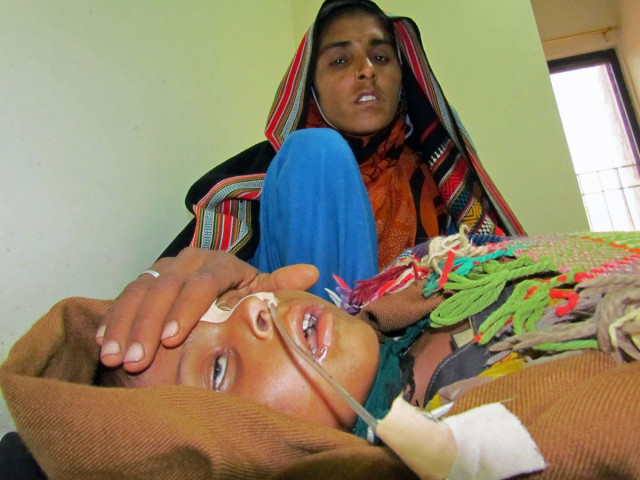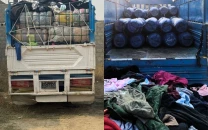Measles outbreak: Blame game persists as death toll racks up
Nine more children fell prey to the measles outbreak in upper Sindh on Saturday.

Death toll 370, according to unofficial sources. PHOTO: AFP/FILE
With a deadly trajectory that commenced in Khairpur’s Thari Mir Wah in November 2012, the measles outbreak has rapidly spread throughout Sindh, despite crash vaccination campaigns throughout the province.
Nine more children fell prey to the measles outbreak in upper Sindh on Saturday, raising the death toll to 370, according to unofficial sources.
According to sources, health authorities sprang into much delayed action after the deaths of approximately 100 children. In the ensuing directives, various health officials were fired on charges of negligence. Reports gathered from different areas of upper Sindh illustrate that responsibility (or part of) lies with health officials. Apparently, the measles vaccines were not being administered for the last few years, leading to the outbreak. In response, health officials have claimed that vaccinators and lady health workers have been preoccupied with the polio campaign at the government’s insistence.
Some sources in the health department added that poor storage conditions have lead to gross wastage of measles vaccines worth millions of rupees. Doctors blame stagnant rain water, poor living conditions, malnourishment and lack of awareness for the rapid spread of the disease. Dr Jay Ram Das, the district health officer in Sukkur, said that the emergency measles vaccination campaign came to a good end, with targets surpassed. The aim was to vaccinate 357,000 children, while overall more than 408,000 children were administered vaccines.
Balochistan
In Balochistan, the death toll reported from measles also varied – the WHO reported 38 deaths; however, health officials say that only six children passed away, defying independent sources, who put the death toll in the province at 13.
Most cases were reported from Pishin, Chaman and Jaffarabad districts of Balochistan.
“As soon as we heard about children being affected, we launched a campaign, especially in Naseerabad, Jhal Magsi and Jaffarabad areas that lie adjacent to districts in Sindh where a measles outbreak is reported,” Health Secretary Asmatullah Kakar told The Express Tribune.
‘One death reported across Punjab’
Meanwhile, even though WHO reported 17 deaths from measles in Punjab, the provincial government has only reported one death so far.
Chairing a meeting, Special Assistant to Punjab Chief Minister on Health Khawaja Salman Rafique directed Executive District Officers (Health) of all districts to carry out vaccination of children in areas where five or more cases have been reported.
K-P, FATA
Areas in Khyber-Pakhtunkhwa (K-P) and the Federally Administered Tribal Areas (Fata) are also in the grip of measles with health experts blaming parents for the rising number of deaths.
According to K-P’s Expanded Programme on Immunisation Deputy Director Dr Jan Baz Afridi, vaccines were “provided to all hospitals in the district but many parents did not bring their children for the second dose of vaccination.”
A doctor in the Hayatabad Medical Complex said that it was most probable that there might be a fault in the vaccine, as many of the children who contracted the disease had been vaccinated before.
In North Waziristan, door-to-door immunisation drives are still a mythical concept. Although the government has provided vaccines to the main hospital in the agency, it is rarely visited by patients.
(With additional input from Noorwali Shah in Peshawar, Ali Usman in Lahore and Mohammad Zafar in Quetta)
What is measles?
Measles is a highly contagious disease caused by a virus in the paramyxovirus family. According to the World Health Organisation (WHO), the measles virus normally grows in the cells that line the back of the throat and lungs. The first sign of measles is usually a high fever, which begins about 10 to 12 days after exposure, and lasts four to seven days. The virus is spread by coughing and sneezing, close personal contact or direct contact with infected nasal or throat secretions. It remains active and contagious in the air or on infected surfaces for up to two hours and can be transmitted by an infected person from four days prior to the onset of the rash to four days after the rash erupts. Unvaccinated young children are at highest risk of measles and its complications. Unfortunately, measles remains one of the leading causes of death among young children globally, despite the availability of a safe and effective vaccine.
Source: WHO website
Published in The Express Tribune, January 13th, 2013.



















COMMENTS
Comments are moderated and generally will be posted if they are on-topic and not abusive.
For more information, please see our Comments FAQ